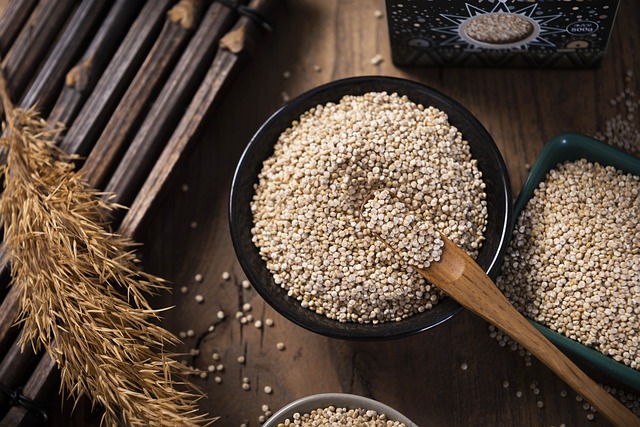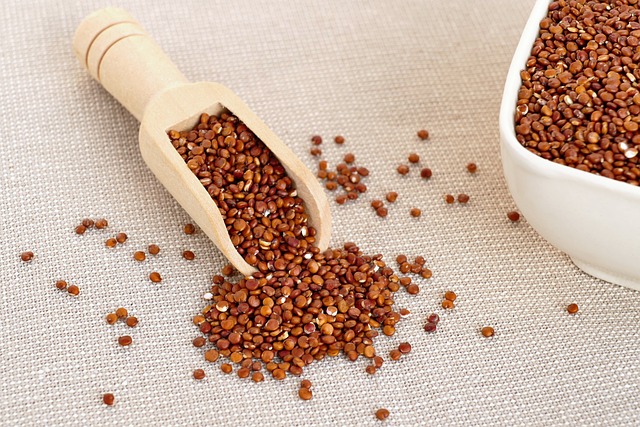Quinoa is a whole grain gaining popularity for its nutritional and health benefits.
Quinoa seeds can be cooked and eaten like most grains, but the plant is more like beetroots and spinach.
Over 120 quinoa varieties are grown. In grocery stores mostly sell white, red, and black quinoa.
This article discusses about the quinoa’s proven health benefits.
Benefits
Regular quinoa consumption has these health benefits.
- Protein from plants
- Plant-based eaters get protein from quinoa.
- Plant-based eaters need non animal protein sources to get enough.
- One cup of cooked 185 gram quinoa contains 8.14 g of protein.
Quinoa proteins contain many amino acids, trusted Source. Muscle development, immune function, and other functions depend on amino acids.
This makes quinoa a great vegetarian or vegan food.
Quinoa, unlike many grains, is rich in Vitamin A reliable lysine source.
An essential amino acid. Lysine is essential for protein synthesis.
lysine deficiency can cause a variety of medical issues because it affects growth and development.
Rich in fiber
Quinoa has 5.18 g Trusted Source of fiber per 185 g cup, more than other grains. At least 15.42% of a person’s daily needs are trusted, depending on age and sex.

The Academy of Nutrition and Dietetics says fiber reduces the risk of
- Constipation
- high cholesterol
- high blood pressure
- diverticulosis.
Fiber-rich diets may help maintain weight. Find out why people need fiber here.
Source of antioxidants
Quinoa is a better gluten-free grain for antioxidants than other grains. Most gluten-free products use corn, rice, or potato flour. These have fewer nutrients than quinoa flour.
Vitamin E in quinoa.
This antioxidant may lower the
- Risk of heart disease
- Cancer
- Eye disorders.
Recent studies confirm the health benefits of whole grains and their antioxidant capacity.
Quinoa has 1.17 mg of manganese per cup. This accounts for 27.43% of male manganese intake from trusted sources and 35.05% for females.
Development and metabolism require manganese, Trusted Source. Good iron source
Quinoa contains 2.76 mg of iron Trusted Source, 34.5% of the recommended daily intake for men and 15.33% for women.
An adequate iron intake is necessary for good health.
The body needs iron for many processes. This compound transports oxygen in the blood, boosting energy and cell function.
Getting enough iron helps connective tissue and muscle metabolism.
Folate is an essential B vitamin that helps form DNATrusted Source. The Office of Dietary Supplements advises pregnant women to get enough folate to prevent neural tube defects.
Consuming enough folate may reduce the risk of depression and several cancers.
A cup of cooked quinoa contains 77.7 mcg of folate, 19.43% of the daily requirement.
Folic acid supplements may be the only way pregnant women can get enough folate. More folate in the diet reduces deficiency risk. Quinoa is rich in folate.
Provides magnesium
One cup of cooked quinoa has 118 mg magnesium.
Age increases the daily recommended amount of the mineral, quinoa is a good source.
Magnesium is in every cell and necessary for over 300 enzymatic reactions.
Low magnesium levels may cause these health issues, according to the ODS:
• High blood pressure
• Cardiovascular disease
• Type 2 diabetes
• Migraine
More research is needed to confirm dietary magnesium’s effects on these conditions.
Quercetin, kaempferol
Quinoa has quercetin and kaempferol.
Antioxidants may shieldTrusted Source from chronic diseases. Kaempferol may prevent infection, heart disease, diabetes, and skin and liver cancers, according to some research.
Quercetin may also boost infection and inflammation defenses.
Nutrition: Quinoa is classified as a pseudocereal, not a grain, by plant experts. It is a nongrassy plant that food producers can use like cereals and grains. Similar nutrition is also present.

Like other grains and cereals, pseudograin seeds can be ground into flour.
Whole grain quinoa is nutritious. Whole grains are the entire grain seed unedited.
Whole grains provide vitamins, minerals, and fiber that are lost when partially processed.
Quinoa is gluten-free.
A cup of cooked quinoa yields:
• 222 kcal
• 8.14 g protein
• 5.18 g fiber
• 3.55 g fat (0.42 g saturated)
• 39.4 g carbohydrate
Quinoa is nutritious and can meet a large portion of a person’s daily nutrient needs, including:
Nutrient Adult daily requirement percentage Magnesium Depending on age and sex,
at least 28.10%Manganese
27.43% male,
25.05% female.
Folate19.43%
Phosphorus40.14%
Copper15.33%
female, 39.44%
maleIron34.5%
Zinc 18.36%
male, 25.25%
female.
Potassium6.77%
Vitamin B-116.5%
Riboflavin18.55% male,
10% female.
Depending on age, quinoa contains approximately 17.54 percent vitamin B-6, as well as traces of vitamin E, B-3, and calcium.
Diet
Quinoa’s bitter saponins repel insects without pesticides.
Quinoa can be rinsed with water Trusted Source before consumption to remove saponins.
Most packaged quinoa has most saponins removed, but it may be rinsed before eating.
Adding quinoa to the diet is simple. It can replace rice in any recipe. Its small grains tenderize in 15 minutes.

Quinoa is versatile because of its subtle nutty taste. It can be baked or eaten for breakfast. Quinoa works in hot sides, cold salads, and burgers.
Gluten-free and ideal for Gluten-intolerant people
Gluten-intolerant people, including celiac disease and non-celiac gluten sensitivity, must avoid gluten (10Trusted Source).
Gluten-free diets require alternatives to wheat, barley, and rye.
Quinoa is naturally gluten-free and a healthy alternative for gluten-free diets.
Quinoa provides nutrients that gluten-free diets lack, unlike refined gluten-free products (11Trusted Source):
The following nutrients are included: fiber, folate, zinc, and magnesium.
High in essential vitamins and minerals
Important nutrients are lacking in many people.
Studies show that many children and adults don’t get enough folate, potassium, iron, and magnesium (13Trusted Source, 14Trusted Source).
Studies estimate that 95% of American adults and children don’t get enough fiber. Fiber deficiency has many health consequences (15Trusted Source).
Quinoa contains fiber and vitamins and minerals that many people lack.
Quinoa provides magnesium, potassium, iron, fiber, and folate, which is crucial for fetal growth and development during pregnancy (14Trusted Source).
Note that quinoa contains anti-nutrients such as saponins, tannins, and phytic acid.
These can bind with iron and magnesium, reducing absorption (16Trusted Source).
Rinsing, soaking, or sprouting quinoa before cooking reduces antinutrients and makes minerals more bioavailable (16Trusted Source).
Quinoa has many oxalates. Oxalates can cause kidney stones, so this may be a concern (17Trusted Source, 18Trusted Source).
Here are some healthy quinoa recipes:
These recipes include quinoa salad, lemon chicken soup, and quinoa breakfast porridge.
• Quinoa-black bean tacos
Related Questions:
Are quinoa and Dalia alike?
Quinoa is the seed of the Amaranth family plant ‘chenopodium quinoa’, while dalia is wheat with husk. Dr. Kumar calls Quinoa a ‘pseudo-grain’ because it’s more like a seed than a grain. Only a few plant-based foods contain essential amino acids.23-Nov-2020
Is quinoa better than rice?
Quinoa has fewer carbs and calories than white rice. Quinoa fibers lower cholesterol and blood sugar, unlike rice. Unlike rice, quinoa lowers post-meal triglycerides. All essential amino acids are more in quinoa.
What is quinoa in Marathi?
Rajgira (राजगिरा) is Marathi. Harvested seeds look like this. The quinoa tree Chenopodium quinoa0.jpg. Rajgira (राजगिरा) is Marathi.